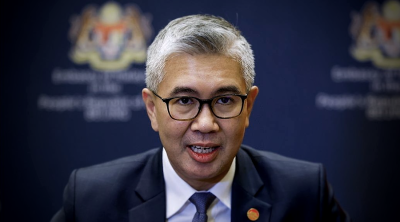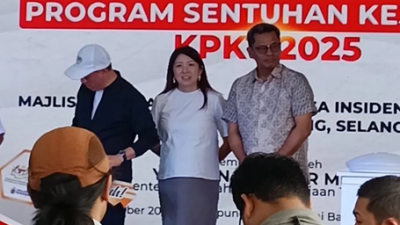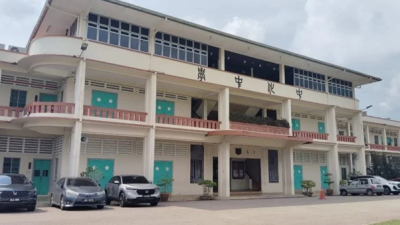
Last Sunday, I completed my first half marathon since 2020.
I was happy to maintain a solid pace to complete the 21.1-km run with a few good friends.
Improving Malaysia’s economic outlook is also like a marathon, not a sprint.
While we have been racing ahead, we must not lose momentum.
The World Bank has revised upwards our growth projections for 2024, from 4.3 per cent to 4.9 per cent, estimating that Malaysia could reach high-income status by 2027.
This is in line with Bank Negara estimates of 4-5 per cent growth this year.
Several factors have contributed to this: a stable political climate, clear communications of economic policy and Malaysia’s unique value proposition to investors.
The “tip of the spear” for much of this success has also been our New Industrial Masterplan (NIMP) 2030, which gives a clear direction to our efforts to attract the right investments — especially in the crucial manufacturing sector.
Almost one year since its launch, the NIMP is already delivering tangible results.
A stellar investment performance
Malaysia’s stellar investment performance is testament to this, with RM160.0 billion of approved investments in the first half of the year, an 18.0 per cent increase year-on-year (y-o-y).
An estimated 79,187 new jobs will be created from 2,948 approved projects, a surge of 49.3 per cent and 11.0 per cent, respectively y-o-y.
Notably, sectors aligned with the National Investment Aspirations brought in RM81.6 billion high-quality investments, representing 51.0 per cent of total approved investments from 562 projects, set to create 35,780 jobs.
There has also been a surge in tech investments this year. Global giants such as Google, Microsoft, AWS and Oracle have chosen Malaysia to build their tech infrastructure for the region, resulting in total investments of US$16.9 billion between them.
Many argue that these tech investments have limited economic spillover, but their actual value is in the creation of various enabling tech ecosystems.
Peripheral industries, both established (such as E&E and chips manufacturing) and nascent (such as cybersecurity and AI), will flourish in tandem.
Malaysia’s strategic role in the global tech trade is also evolving as companies seek more resilient supply chains.
Production-wise, the shift from a just-intime model to a just-in-case approach —building capacity for sudden surges or interruptions — has allowed Malaysia to become a preferred partner for multinationals needing reliable, advanced manufacturing bases in Southeast Asia.
Meanwhile, with our Green Investment Strategy and NIMP paving the way, green investments have also surged, strengthening our role in, for example, Southeast Asia’s electric vehicle (EV) ecosystem, driven by partnerships with global automakers and local innovators.
The government’s commitment to clean energy and green technologies is likewise attracting investors looking to tap into Malaysian expertise in battery production, EV infrastructure, and hydrogen technologies.
Trade forging ahead
In the first eight months of the year, Malaysia’s trade maintained its upward trajectory with exports and imports registering strong expansion.
Total trade increased by 10.9 per cent y-o-y, reaching RM1.9 trillion – the highest periodic trade value ever registered.
This year, demand for semiconductors and advanced electronics surged as digital transformation and AI-driven initiatives across the globe accelerated.
The proliferation of 5G technology, Internet of Things (IoT) devices, and cloud computing in major economies has expanded demand for high-quality electronic components, giving Malaysia an edge as a leading exporter of these critical technologies.
Additionally, we have strengthened our integration into global supply chains by investing in research and development (R&D) in sectors such as quantum computing and artificial intelligence (AI), enabling our industries to adapt swiftly to the rapid pace of technological change.
We have also focused on diversifying our trade sources.
Expansion into new markets, particularly in Africa, the Middle East, and Latin America, can unlock new growth opportunities.
There’s a need to continue leveraging on the 16 free trade agreements (FTAs) we have, such as the Regional Comprehensive Economic Partnership (RCEP) and the Comprehensive and Progressive Agreement for Trans-Pacific Partnership (CPTPP), and explore more bilateral agreements to provide greater market access for Malaysian goods and services.
Within ASEAN, we are looking to conclude negotiations on the upgraded ASEAN Trade in Goods Agreement (ATIGA) in 2025 to maximise the advantages of regional integration.
NIMP also about economic inclusivity
The NIMP has also focused on increasing economic inclusivity, ensuring that participation in trade and industry is ramped up, such as through the development of cross-state industrial clusters.
By clustering our natural and established strengths through existing industrial belts, Malaysia is fostering a more, even, diverse and inclusive industrial base across more states.
The nation’s industrial growth strategy has also been significantly energised by collaborations between industry and academia to ensure a future-ready workforce.
For instance, efforts like the Joint Curriculum Development between industry leaders and educators, along with closer collaboration between MITI, the Government-Industry TVET Coordination Body (GITC), and the Ministry of Higher Education, have laid a strong foundation for meeting the skilled workforce needs.
Additionally, MITI agencies like the Malaysian Investment Development Authority (MIDA), Collaborative Research in Engineering, Science and Technology (CREST), and the Malaysia Productivity Corporation (MPC) are active in nurturing industry-academia partnerships to cultivate talents tailored for specific industries, reinforcing Malaysia’s competitiveness in the global market.
The aim is to increase not only employment, but also the employability of our workforce.
Leveraging on ASEAN
Moving forward, we have plenty to be excited about. ASEAN as a bloc has been resilient in the face of geopolitical and economic tensions, and as long as we remain true to the ASEAN Way, boost intra-ASEAN trade and investment, as well as future-proof our industries, we will continue to rise.
While pursuing these goals as ASEAN chair next year, Malaysia can likewise position itself as a key hub for manufacturing and services.
By advocating for policies that streamline trade, reduce tariffs, and enhance supply chain efficiency, we can attract more foreign direct investment in advanced manufacturing, especially in critical sectors like E&E, green technologies and automotive.
Additionally, initiatives like the ASEAN Digital Economy Framework Agreement will boost Malaysia’s role as a regional hub for digital services, fintech, and e-commerce–especially for our Micro, Small and Medium Enterprises (MSMEs), making them competitive internationally.
With these strategic moves, our country can cement its position as a gateway to ASEAN, driving growth and long-term investment across the region.
Returning to the marathon analogy: we have a tough race ahead of us. But the NIMP and other government’s policies are lighting up the route and building the endurance we need to make it to the finish line, and there is a high chance we will be ahead of the pack!
(Tengku Zafrul Tengku Abdul Aziz is the Minister of Investment, Trade and Industry, Malaysia.)
ADVERTISEMENT
ADVERTISEMENT






































